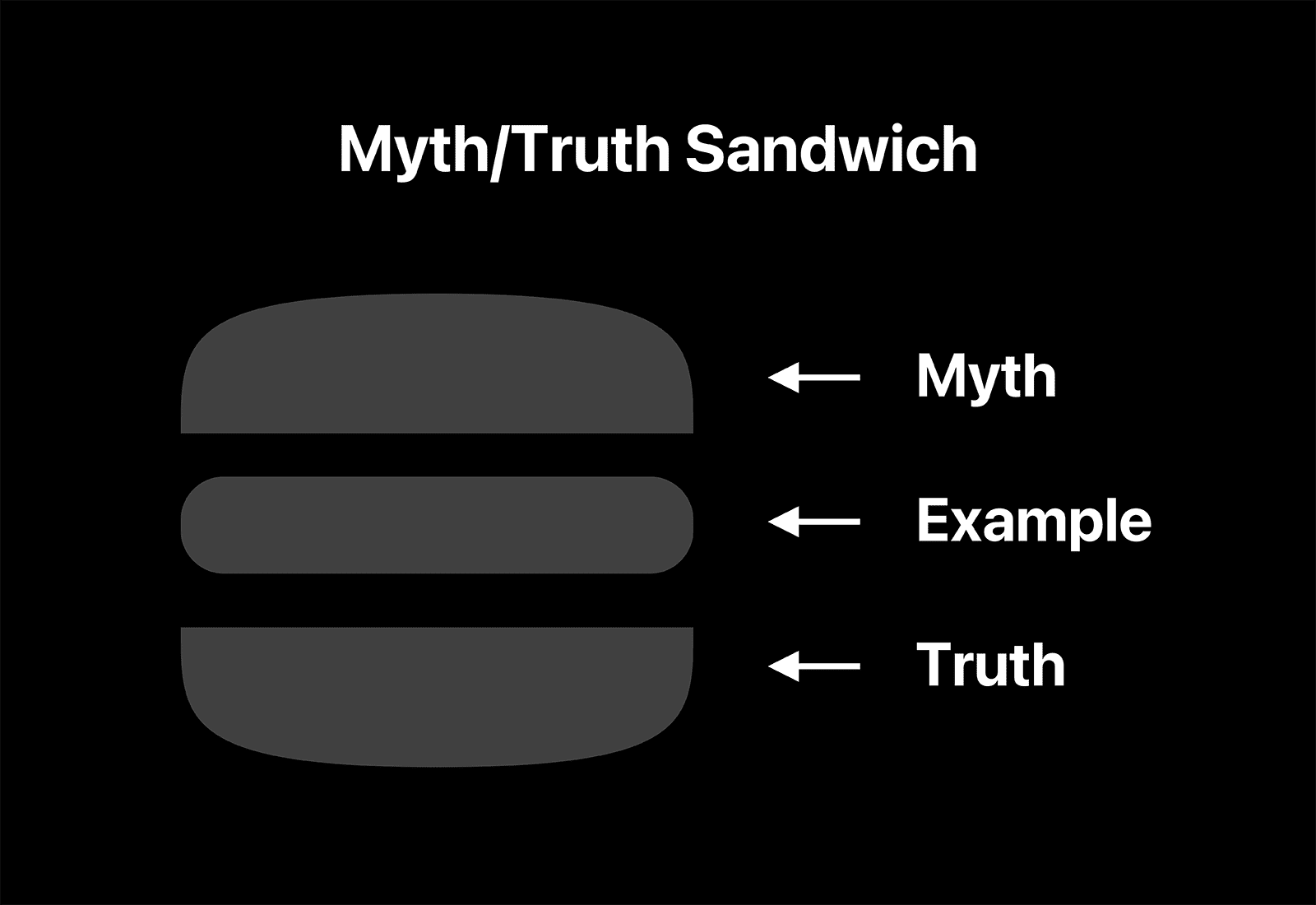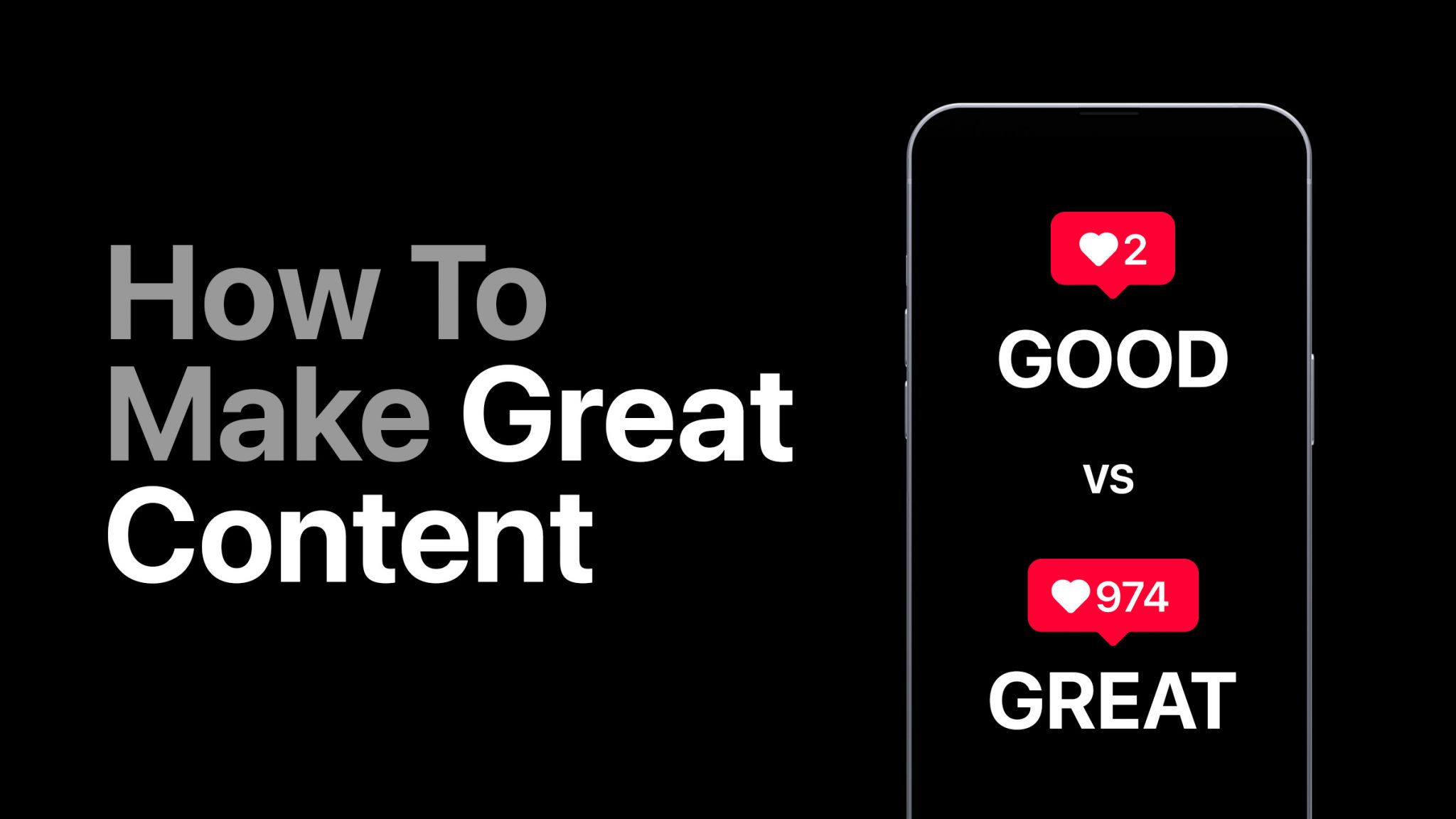Good content gives people the answers. Great content gets them ask questions. It makes them say “I never thought of it that way”.
To make great content, do NOT give advice in your content. Instead, DEBUNK the advice. Here’s how.
Did I ever tell you my superpower?
It’s making people say “I never thought of it that way”. Seriously 😁.
I LOVE hearing people say that because it means I showed them a different perspective that they already knew, but “never thought of”.
It also means I don’t have to try to change their mind. Most likely they’ll end up changing their own mind.
You can achieve this by using what I call the myth/truth sandwich:

I’ve talked about the myth/truth sandwich before, but now I’ve reverse engineered exactly how I do this and put it into a 4-step process.
Get excited, because this is brand new and I’m sharing it with you first!
Step 1: Myth
What are some common myths that your audience believe?
These can also be common misconceptions you hear from your audience or objections you get in sales meetings.
Here are few common myths in my industry:
- Do what you love
- Fire your boss
- Big agencies are better
- People are motivated by success
- Morning routines are important
- Charge what you’re worth
- Your work speaks for itself
- Education makes you smart
- Be passionate in your business
- Chase passion, not money
- Email is dead
Now try to come up with your own list for your industry.
Important Tip: DO NOT make up a myth that only few people believe. Just because you believe something it doesn’t mean everyone else does. For example “yoga is difficult” is not a myth.
Step 2: Truth
Here’s a little secret 🤫
Almost everything can be turned into a myth because the answer to most questions aren’t “yes” or “no”. It’s usually “it depends…”
This is why the “truth” isn’t necessarily the opposite of myth. It’s more nuanced than that. It’s somewhere in between.
Here are few ways you can debunk any myth:
1. Pros & cons
Every advice has pros and cons.
That’s because strengths and weaknesses are two sides of the same coin. For example, you might think being “impatient” is a weakness, but it can also mean “proactive”, which is a strength.
Go through the common myths you came up with and come up with pros and cons for each one.
Here’s an example:
What are the pros of working with a big agency?
- They have an impressive portfolio
- They have a robust process
- They have a project manager to handle problems
What are the cons of working with a big agency?
- You’ll get stuck with the B team (or C team)
- There’s less flexibility because of processes
- Everything has to go through the middle man
Now you have the myth & truth:
You may think a big agency has an impressive portfolio…
But that’s just from their A team. Unless you’re Apple or Coca Cola, you’ll be stuck with their B or C team.
2. Circumstances & context
Blanket statements are rarely true. Most advices depends on context or circumstances of the person receiving the advice.
Here’s an example:
If you’re a recent college grad working a 9 to 5 job you hate, the right advice might be to “not worry about money and do what you love”.
But if you’re a single mom who is working 2 jobs and barely making ends meet, the right advice would be to “take the highest paying job and save money first”.
Here’s another example:
If you’ve been doing your own social media and it’s taking too much time away from your business, the right advice might be to “hire someone and delegate”.
But if you don’t know anything about social media, you won’t know if you hired the right person or if they’re doing a good job, so “you might waste time and money by delegating”.
3. Personality differences
Just because an advice worked for one person, doesn’t mean it’ll work for another. Personality makes a difference.
Here’s an example:
For someone who is selling themselves short because they’re a people pleaser or have imposter syndrome, the right advice might be: “know your value and charge what you’re worth”.
On the other hand, for someone who is over-confident and keeps telling people “I’m not cheap” even though they have no experience, that advice would be dangerous. The right advice for them might be to “work for less and gain experience”.
4. Expectation vs reality
If you’re an experienced veteran, you probably know that newbies coming into the field might have one expectation when the reality is very different.
Figure out which of the myths are “expectations” that people believe and what “reality” actually looks like.
Here’s an example:
If you’re a 9 to 5 employee or a new entrepreneur, you might think firing your boss will give you freedom. Your expectation might be that “you won’t have a boss anymore”.
In “reality”, when you start your own business, that freedom comes responsibility. You have to make sure you make your own paycheck, so “ALL of your customers are now your bosses”.
5. Misunderstood advices
Some advices have been around for so long that over time, it’s lost its original meaning. They’re misunderstood.
If this is the case, you can debunk it by correcting it.
Here’s an example:
Some people might hear “quality over quantity” and think that everything they do have to be perfect. But that only applies to people who are already experts at what they do, not someone who’s starting out.
This causes newbies to go into overthinking and their perfectionism stops them from starting. The truth is, you have to start messy, put in a lot of practice, and over time “quantity leads quality”.
Step 3: Example
Whenever I give someone an advice or teach them something, they pretend to understand. Then as soon as I give an example, they go “ahhh, NOW I get it” 🤦♂️.
That’s because the best way to show an idea is by using examples.
Come up with an obvious example that goes against the myth.
It’s SOOOO IMPORTANT that your audience agree with the example. If not they’ll just say “that’s not true” and this whole thing falls apart.
Here are 6 different types of examples you can give:
1. Common sense
Most people are blinded by popular quotes and advices that they forget to use their common sense.
By thinking through some of the myth/truths, you should be able to come up with obvious examples from everyday situations.
Here are some examples:
https://www.instagram.com/p/ClghZgIO0Li/
https://www.instagram.com/p/CpAolP8ulWT/
https://www.instagram.com/reel/CbNMRuWA9E8/
https://www.instagram.com/reel/B_YTHycnRJJ/
2. Analogies or metaphors
A simple way to make someone understand something is to compare it to something else they already know. See if you can find an analogy or metaphor for what you’re trying to explain.
Here are some examples:
https://www.instagram.com/reel/Couk8b0rat0/
https://www.instagram.com/p/CpKzhICOzpk/
https://www.instagram.com/reel/CnHyWvwrFtG/
https://www.instagram.com/p/ClqvBsCAx1b/
3. Story or anecdote
Give an example from your own personal life or a story you heard from someone. The story has to be believable otherwise it won’t work.
Here are some examples:
https://www.instagram.com/p/CmeV3c5ukkA/
https://www.instagram.com/reel/CEhUcnZHJ0P/
https://www.instagram.com/p/CmJ3NwruRJw/
https://www.instagram.com/p/Cl9NE8BusdS/
https://www.instagram.com/p/Cj-qvElgpHK/
4. Popular movies, TV shows, or characters
Can’t think of a story in your own life? No worries, you can try to find one from a popular story that everyone already knows.
Here are some examples:
https://www.instagram.com/p/Cr0m1S1ALbj/
https://www.instagram.com/reel/CqYUP_yvVXS/
https://www.instagram.com/reel/CnM7x8Xr4sC/
https://www.instagram.com/reel/CeZHIJ2FxNl/
5. Repetition
Sometimes you can really prove a point by showing a lot of “quick” examples that support your statement.
Here are some examples:
https://www.instagram.com/p/CqnXnyrgKeP/
https://www.instagram.com/p/Cl1lvargXDH/
https://www.instagram.com/p/CmWnVLrOA7g/
https://www.instagram.com/p/CmMi8TruX6r/
6. Science, data, or case study
You can backup your statement by using an example from an existing study that’s been done by the experts.
Here are some examples:
https://www.instagram.com/p/CmrHYpmNK3c/
https://www.instagram.com/p/CrTIpo9Al2c/
https://www.instagram.com/p/CrvdQzugxzj/
https://www.instagram.com/reel/CdBrPFaFtfu/
Step 4: The Sandwich
Now that we have all the ingredients (myth, truth, and example), it’s time to build your myth/truth sandwich.
Make your sandwich in this order:
1. Hook
Hooks should be shocking, unpopular or mysterious to grab people’s attention. There’s no room for nuance here. (and don’t worry about trolls)
To do this, make the opposite statement of the myth. Remember, this isn’t the same as the “truth”. It’s just a hook.
Here are some examples of hooks (for each myth):
Myth: Do what you love
Hook: Don’t do what you loveMyth: Fire your boss
Hook: Hire your bossMyth: Big agencies are better
Hook: Why big agencies suckMyth: People are motivated by success
Hook: People don’t want successMyth: Morning routines are important
Hook: Dark truth about morning routinesMyth: Charge what you’re worth
Hook: Don’t charge what you’re worthMyth: Be passionate in your business
Hook: How passion ruins your businessMyth: Chase passion, not money
Hook: Chase money, not passion
2. Myth
After the hook, state the myth you’re trying to debunk. The juxtaposition between the myth and the hook makes the audience more interested in what’s about to come next.
3. Example
Instead of jumping right from the myth to the truth, it works best if you state the example first. If you come up with the right example (from step 3) they should agree with the example, and at the same time, realize how it contradicts the myth.
4. Truth
Finally hit them with the truth.
Remember that the truth is not the opposite of myth. It’s a nuanced version somewhere in between the truth and the myth. Myth might be correct sometimes, but other times it’s incorrect.
Here’s an example of a completed myth/truth sandwich:
HOOK
Google hires bad programmers.MYTH
Most people think the best programmers work for big companies like Google, Apple, or Microsoft.EXAMPLE
I was considered one of the best programmers, and when I was interviewing, I didn’t want to work at Google because they already had a perfect process that I had to follow. There was nothing for me to fix. It sounded boring, like a high paid, glorified manual labor.
I wanted to work at the smallest company where “I” can be the one who fix the company by building my own process.TRUTH
Big companies attract programmers who just want cushy job and follow process. They might be smart, but they’re also “safe”.
The most proactive programmers who take risks and want to build from ground up, work at small companies. And these are really the “best” programmers.
And that’s how it’s done folks!
Sounds easy right? Trust me, it’s not…
Do you ever learn something from a book or an online course, then you try to apply it for yourself and it doesn’t quite work the same?
Most lessons you learn are “easier said than done”.
Just like riding a bike, you can’t learn storytelling from a book. It requires practice. Then eventually comes a moment when you “get” it.
That’s why I created Night Owl Nation to be a peer-to-peer learning community where we can practice together. If you REALLY want to practice storytelling with content creators who can help you when you get stuck: join us!
That’s it for today and until next Wednesday, cheers {{ subscriber.first_name }}! 👋
The Most Valuable F*cking Emails
Guaranteed to make you say:
I never thought of it that way!
Enter your name and email to get'em:
